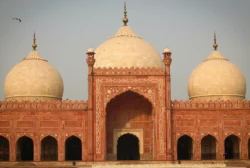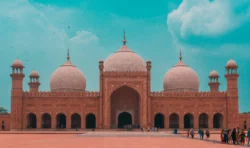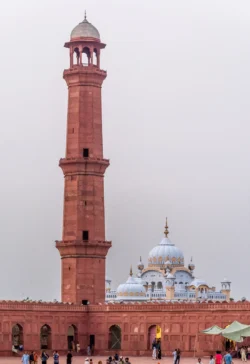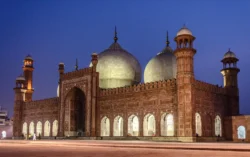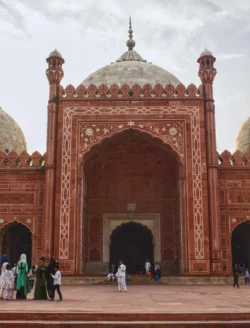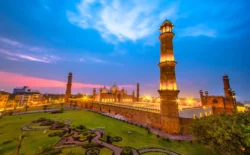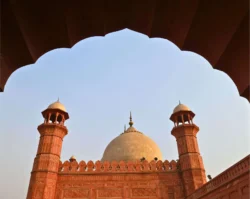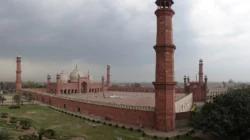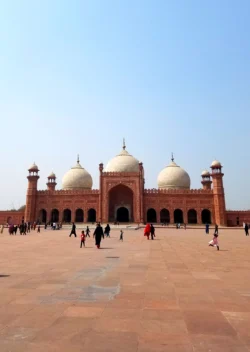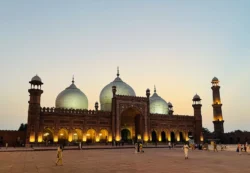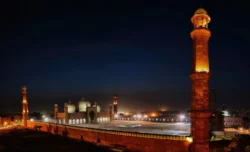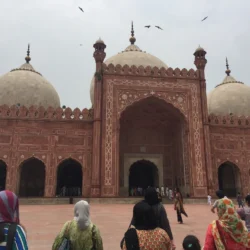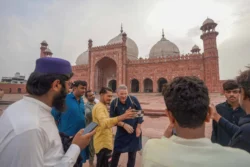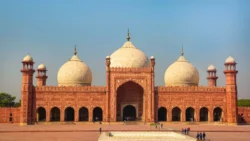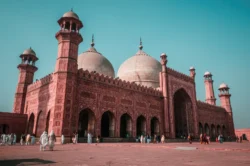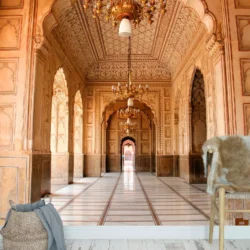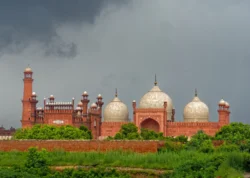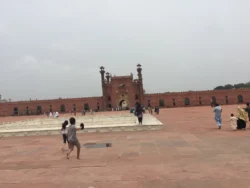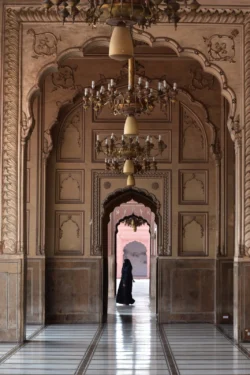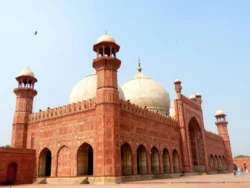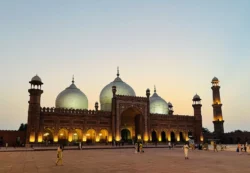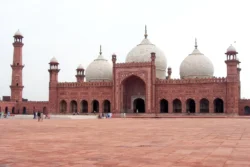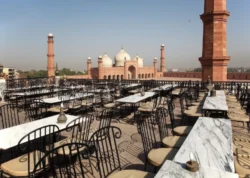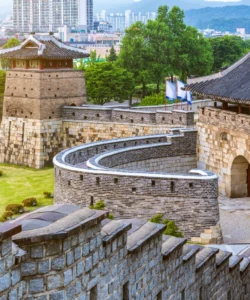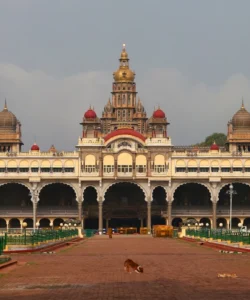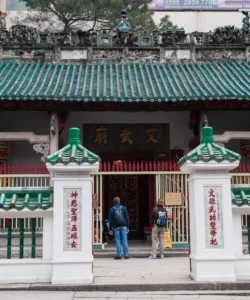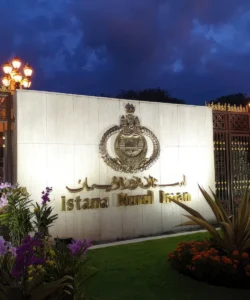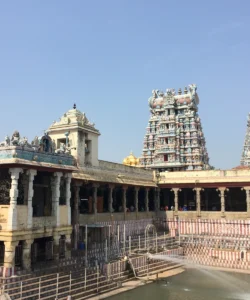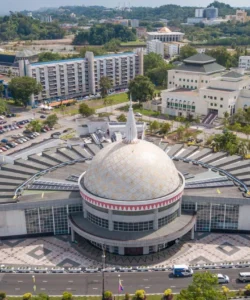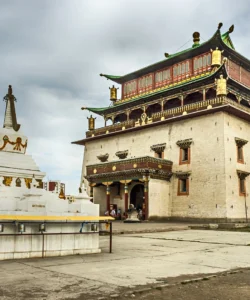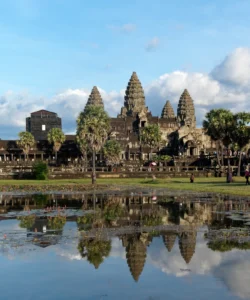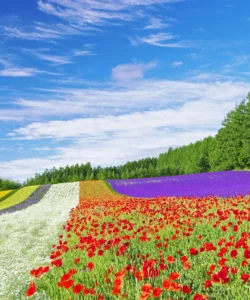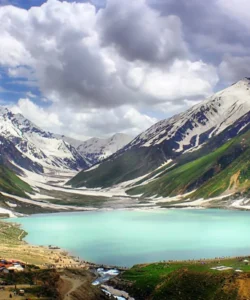The Badshahi Mosque (Urdu: بادشاہی مسجد, lit. ‘Imperial Mosque’) is a monumental mosque located in Lahore, Punjab, Pakistan. Commissioned by the sixth Mughal Emperor Aurangzeb in 1671, it was the largest mosque in the world upon its completion and remained so for over 300 years. It stands as one of the last great architectural masterpieces of the Mughal era and is a powerful symbol of Islamic heritage in Pakistan.
Name: Badshahi Mosque (also known as Shahi Masjid, meaning “Royal Mosque” or “Emperor’s Mosque”)
Address: Fort Rd, Walled City of Lahore, Lahore, Punjab, Pakistan. It is strategically located opposite the iconic Alamgiri Gate of the Lahore Fort, with the Hazuri Bagh (a Mughal garden) separating the two landmarks, forming the historical heart of Lahore.
How to Get There:
The Badshahi Mosque is a prime tourist attraction in Lahore and is easily accessible:
- By Air: The closest airport is Allama Iqbal International Airport (LHE) in Lahore. From the airport, it’s approximately a 30-45 minute taxi or ride-hailing (Careem, Uber) trip to the mosque.
- By Train: Lahore Railway Station is well-connected to major cities within Pakistan. From the station, the mosque is about 4-5 kilometers away, a short 15-20 minute ride by rickshaw or taxi.
- By Road: Lahore has a well-established network of roads. You can reach the mosque using public transport like buses, rickshaws, and taxis. Ride-hailing apps like Careem and Uber are widely available.
- The Lahore Metro Bus Service has a station at Azadi Chowk, which is within walking distance of the mosque, or a short rickshaw ride away.
- Walking: If you are exploring the Walled City of Lahore, the mosque is often a key stop within a walking tour.
- Entrance Fee: There is typically a nominal entrance fee for non-Muslim visitors to the mosque. Modest dress is required (shoulders and knees covered). Footwear must be removed before entering the main courtyard. Shoe storage facilities are available.
- Best Time to Visit: The best time to visit Lahore is from October to March, when the weather is cooler and pleasant. Visiting the mosque early in the morning or late afternoon/evening is recommended to avoid crowds and experience its beauty in different light conditions. It may be closed to non-Muslims during prayer times, especially on Fridays.
Landscape and Architecture:
The Badshahi Mosque is a monumental structure, a pinnacle of Mughal architecture that blends grandeur with intricate detailing.
- Vast Courtyard and Grand Scale: The mosque is renowned for its immense scale. Its vast courtyard, spreading over 276,000 square feet (25,600 square meters), can accommodate up to 100,000 worshippers, making it one of the largest mosque courtyards in the world. The sheer size of the complex is designed to inspire awe.
- Red Sandstone and White Marble: The exterior of the mosque is primarily constructed of red sandstone, giving it a commanding and regal appearance. This red sandstone is beautifully contrasted with white marble inlay used for floral designs, intricate paneling, and the cladding of its three prominent domes. This material combination is a hallmark of high Mughal architecture.
- Three Marble Domes: The main prayer hall is crowned by three gigantic marble domes, the central one being the largest and most prominent, flanked by two smaller ones. These bulbous domes are finished in white marble and topped with golden finials, contributing to the mosque’s majestic silhouette.
- Four Octagonal Minarets: At each of the four corners of the mosque’s main building stand octagonal, three-story minarets, rising to a height of 60 meters (196 feet). These towering minarets frame the mosque beautifully and are taller than those of the Taj Mahal. They are topped with marble canopies and adorned with intricate carvings.
- Two-Storey Entryway: Entrance to the mosque complex is via a grand, two-storey edifice built of red sandstone, elaborately decorated with framed and carved paneling. This massive gateway itself contains several chambers.
- Prayer Hall: The main prayer hall is a large, rectangular edifice built of red sandstone with extensive white marble inlay. Its interior is richly embellished with stucco tracery (manbatkari), frescoes, and intricate floral motifs, reflecting the peak of Mughal craftsmanship. It features a central arched niche flanked by smaller niches.
- Symmetry and Harmony: Like other Mughal masterpieces, the Badshahi Mosque embodies a strong sense of symmetry and balance in its design, reflecting the Mughal appreciation for geometric precision and harmony.
- Hazuri Bagh: The garden known as Hazuri Bagh, located between the mosque and the Lahore Fort, separates these two iconic structures, creating an open space that enhances the visual impact of both.
- Tomb of Allama Iqbal: Adjacent to the Badshahi Mosque is the tomb of Muhammad Iqbal, Pakistan’s national poet, adding another layer of cultural and national significance to the immediate surroundings.
What Makes It Famous:
- Largest Mosque in the World (Historically): Upon its completion in 1673, the Badshahi Mosque was the largest mosque in the world, a title it held for over 300 years until 1986. It remains one of the largest mosques globally today and the third-largest in Pakistan.
- Mughal Architectural Masterpiece: Commissioned by Emperor Aurangzeb, it represents the zenith of Mughal architecture in Pakistan, showcasing the empire’s distinctive style, grandeur, and artistic achievements in red sandstone and marble.
- Iconic Lahore Landmark: The Badshahi Mosque is arguably the most recognizable and famous landmark of Lahore, synonymous with the city’s rich history and cultural heritage.
- Historical Significance and Resilience: It has witnessed centuries of history, from its role as an imperial mosque under Aurangzeb to its controversial use as a military garrison by the Sikh Empire and later the British Raj, before its extensive restoration in the 20th century. This history of transformation and resilience adds to its fame.
- Symbol of Islamic Heritage: It stands as a powerful symbol of Islamic faith and heritage in Pakistan, continuing to be an active place of worship for thousands.
- Site of International Islamic Gatherings: In 1974, it hosted the Second Islamic Summit, where leaders from 39 Muslim states offered prayers, highlighting its importance in the broader Islamic world.
- Connection to Lahore Fort: Its strategic location directly opposite the Lahore Fort, connected by the Hazuri Bagh, forms a visually stunning and historically significant complex.
Differences from Some Other Wonders:
- Historically Largest Mosque: While other mosques like the Sultan Omar Ali Saifuddien Mosque or Jame’ Asr Hassanil Bolkiah Mosque are grand and beautiful, the Badshahi Mosque’s distinction lies in its historical record as being the largest mosque in the world for over three centuries.
- Emperor Aurangzeb’s Patronage: Unlike the Taj Mahal (built by Shah Jahan as a monument of love) or other Mughal structures known for specific emperors’ distinct aesthetic (e.g., Akbar’s use of Hindu motifs), the Badshahi Mosque is a key architectural work by Emperor Aurangzeb, who was known more for his austere religious piety than extensive architectural patronage. It nonetheless demonstrates immense grandeur, possibly symbolizing his authority.
- Use of Red Sandstone with White Marble Inlay (Specific Balance): While the Jama Masjid in Delhi (built by Shah Jahan) shares a similar design and materials, the Badshahi Mosque uses a particular balance of red sandstone as the dominant exterior material with extensive white marble inlay, contrasting with the primary white marble of the Taj Mahal or the red sandstone dominance of Delhi’s Red Fort.
- Military Garrison History: Its unique period of use as a military garrison and stable under Sikh and British rule, and its subsequent restoration for religious worship, gives it a specific historical narrative of desecration and revival not typically associated with other major mosques.
- Direct Counterpart to Lahore Fort: Its design and positioning directly opposite the Lahore Fort, with its own Alamgiri Gate mirroring the fort’s, creates a very deliberate and grand complex of imperial power and piety, making the two structures inseparable in their historical and visual impact.
- Lack of UNESCO World Heritage Status (Currently Tentative): While many Mughal sites are already UNESCO WHS (Taj Mahal, Red Fort, Humayun’s Tomb), the Badshahi Mosque is currently on UNESCO’s tentative list, making it a future contender for this international recognition.
Badshahi Mosque Photos:



